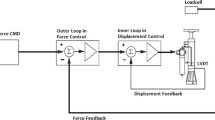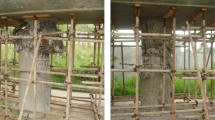Abstract
The real-time hybrid test (RTHT) is designed to predict structural dynamic behavior through the interactions between the physical substructure and numerical model. This study sought to develop the computational algorithm and to optimize the control system with such. Specifically, Finite Element Analysis Program for Hybrid (FEAPH), a nonlinear finite element analysis program for hybrid only, was developed. To shorten the computational time, FEAPH employed the fixed number iteration method and parallel computational technique. Furthermore, in the real-time control system, the inter-communication between a substructure and an analysis program was simplified. To verify the reliability and applicability of the system, nonlinear multi-directional tests of 3DOFs were conducted on a steel frame structure. The RTHT with FEAPH revealed better improvement in terms of testing time and experimental errors. Therefore, the RTHT method using FEAPH can be utilized as an efficient, economical testing method in predicting structural dynamic behaviors.
Similar content being viewed by others
References
Kim, S., Lee, D., and Cuong, N., “Shaking Table Tests of a Two-Story Unbraced Steel Frame,” KSCE 25(4A):601–609 (2005).
Hakuno M, Shidawara M, Hara T (1969) “Dynamic Destructive Test of a Cantilever Beam Controlled by an Analog Computer”, Transactions of the Japan Society of Civil Engineers 171:1–9(in Japanese)
Takanashi, K., and Nakashima, M., “Japanese Activities on Online Testing,” Journal of Engineering Mechanics 113(7):1014–1032 (1987).
Mahin, S.A., Shing, P.S.B., Thewalt, C.R., and Hanson, R.D., “Pseudo-Dynamic Test Method: Current Status and Future Direction,” Journal of Engineering Mechanics 115:2113–2128 (1989).
Shing, P.B., Nakashima, M., and Bursi, O.S., “Application of Pseudo-Dynamic Test Method to Structural Research,” Earthquake Spectra 12(1):1121–1141 (1996).
Nakashima, M., “Development, Potential, and Limitations of Real-Time Online (Pseudo-Dynamic) Testing,” Philosophical Transactions of the Royal Society of London 359:1851–1867 (2001).
Darby, A.P., Blakeborough, A., and Williams, M.S., “Real-Time Substructure Tests Using Hydraulic Actuator,” Journal of Engineering Mechanics 125:1133–1139 (1999).
Darby, A.P., Blakeborough, A., and Williams, M.S., “Improved Control Algorithm for Real-Time Substructure Testing,” Earthquake Engineering and Structural Dynamics 30(3):431–448 (2001).
McKenna, F.T., Object-Oriented Finite Element Programming: Frameworks for Analysis, Algorithms, and Parallel Computing, PhD thesis, University of California, Berkeley, CA (1997).
Fenves, G.L., McKenna, F., Scott, M.H., and Takahashi, Y., “An Object-Oriented Software Environment for Collaborative Network Simulation,” Proceedings of the 13th WCEE, Vancouver, Canada, 2004.
Schellenberg, A, and Mahin, S “Integration of hybrid simulation within the general-purpose computational framework OpenSees,” Proceedings of the 8th National Conference on Earthquake Engineering, EERI, San Francisco, CA, 2006.
Jung, R.Y., and Shing, P.B., “Performance Evaluation of a Real-Time Pseudo-Dynamic Test System,” Earthquake Engineering and Structural Dynamics 35(7):789–810 (2006).
Saouma, V., Kang, D.H., and Haussmann, G., “A Computational Finite Element Program for Hybrid Simulation,” Earthquake Engineering and Structural Dynamics 41(3):375–389 (2011).
Kang, D.H., An Optimized Computational Environment for Real-Time Hybrid Simulation, PhD thesis, University of Colorado, Boulder, CO (2010).
Cho, S., Improvement of Hybrid Test System and Its Application to a Small Experimental Model, thesis, MyongJi University, Seoul, South Korea (2011).
Lee, J., Evaluation of Applicability and Reliability for Hybrid Testing, thesis, Inha University, Incheon, South Korea (2012).
Kim, S., Na, O., Kim, S., Lee, J., and Kang, D. “Single Degree of Freedom Hybrid Dynamic Test with Steel Frame Structure,” Journal of KSR 5(4):413–421 (2012).
Wei, Z., Fast hybrid Test System for Substructure Evaluation, PhD thesis, University of Colorado, Boulder, CO (2005).
Chen, C., and Ricles, J.M., “Analysis of Implicit HHT-α Integration Algorithm for Real-Time Hybrid Simulation,” Earthquake Engineering and Structural Dynamics 41:1021–1041 (2012).
Chen, C., Ricles, J.M., Karavasilis, T.L., et al., “Evaluation of a Real-Time Hybrid Simulation System for Performance Evaluation of Structures with Rate-Dependent Devices Subjected to Seismic Loading,” Engineering Structures 35:71–82 (2012).
American Institute of Steel Construction Inc, Seismic Provisions for Structural Steel Buildings, AISC, Chicago, IL (2002).
Yamaguchi, N., Minowa, C., “Energy-Based Evaluation Method of Seismic Performance of Timber Structures,” Proceedings of the 13th WCEE, Vancouver, Canada, 2004.
Author information
Authors and Affiliations
Corresponding author
Rights and permissions
About this article
Cite this article
Na, O., Kim, S. & Kim, S. Multi-Directional Structural Dynamic Test using Optimized Real-time Hybrid Control System. Exp Tech 40, 441–452 (2016). https://doi.org/10.1007/s40799-016-0047-3
Published:
Issue Date:
DOI: https://doi.org/10.1007/s40799-016-0047-3




